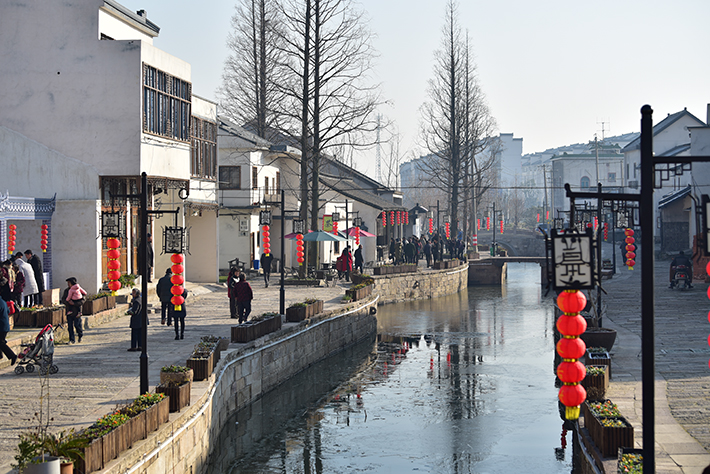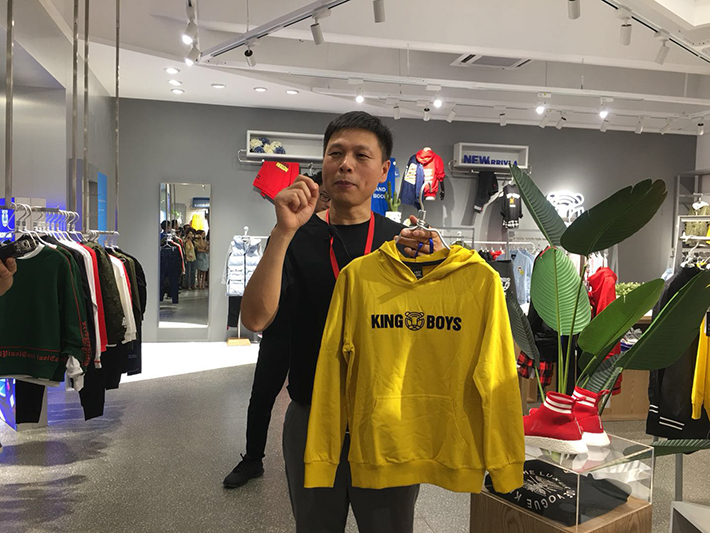|
||||||||||
| Home Nation World Business Opinion Lifestyle ChinAfrica Multimedia Columnists Documents Special Reports |
|
||||||||||
| Home Nation World Business Opinion Lifestyle ChinAfrica Multimedia Columnists Documents Special Reports |
| ChinAfrica |
| Sewing Success |
| An impoverished town grows to become the children's wear manufacturing capital of China |
| By Wen Qing | VOL.10 October ·2018-10-18 |

The village of Yigao in Zhili Town, Huzhou City of east China's Zhejiang Province, during the Fourth Gucheng Cultural Tourism Festival on January 13 (COURTESY PHOTO)
Pu Xinquan, Managing Director of the King Boy & King Girl Clothes Co., is animated as he introduces a yellow children's hoodie to a customer on August 22 at one of his stores in Zhili, a small town in east China's Zhejiang Province.
"This pullover is made from 100-percent cotton. It is stretchy and comfortable for kids, and is also the latest style this autumn," he said.
Like many other successful business people in the town, Pu did not receive much of an education and started working at an early age trying many different fields. During the 1990s, many people around him began to make a fortune in the children's wear industry. Pu, seeing the huge business potential, took the plunge.
"In 1996, I bought 2 mu (1,333 square meters) of land and six sewing machines to build a small workshop, and started my career," Pu told ChinAfrica. After two decades of development, Pu's family workshop grew into the King Boy & King Girl Clothes Co., which registered sales of around 270 million yuan ($40 million) in 2017.
Pu's story reflects the leapfrog progress of his hometown, Zhili, which evolved from a small, poor village into a prosperous town with one of the most thriving private economies in China, over the four decades since the introduction of the reform and opening-up policy in 1978.

Pu Xinquan, Managing Director of the King Boy & King Girl Clothes Co., introduces a children’s hoodie to a customer on August 22 in Zhili (WEN QING)
Children's wear capital
Zhili, a small town located in Huzhou, has long been known as the center of China's children's wear industry. There are around 13,000 companies producing 1.3 billion pieces of clothing in the town every year, which equates to more than 50 percent of China's children's clothing. In 2017, Zhili's total GDP reached 20.3 billion yuan ($3 billion).
Yet in the 1970s, it was a rundown village where the local people struggled to eke out a basic existence. "At that time, Zhili was known as a backwater due to rapid population growth and limited arable land," said Wu Zhiyong, Secretary of the Communist Party of China Wuxing District Committee in Huzhou.
Zhili remained this way until the implementation of reform and opening up in 1978. In the mid-1980s, those with a sharp business minds were trying their hand at the children's wear industry, where profits were bigger than other areas of work at the time. "Every household could become a small family workshop as long as it had a sewing machine," Wu noted. The children's wear industry boomed in Zhili throughout the 1990s following Deng Xiaoping's speeches on his tour of the south in 1992, in which he called for local governments to take more measures to deepen economic reform.
After four decades of development, Zhili has established a complete industry chain of children's wear from design and manufacture, to storage, logistics and retail.
Zhili's development has also provided opportunities for people from other parts of the country. The town's reputation has attracted 350,000 people from across China.
For Cao Miaohong and his wife, who come from east China's Anhui Province, Zhili has become their second home. "My wife and I work as sewing machine operators at a children's wear factory where we can earn 160,000 yuan ($23,000) a year with a three-month holiday," Cao said. The influx of people has in turn provided rich human resources for the further development of the industry in Zhili.
Brand building
Despite its success, Zhili's entrepreneurs are not about to rest on their laurels. In recent years, children's wear businesses have been striving to upgrade themselves by nurturing more famous brands and expanding sales via e-commerce.
According to research provided by the local government, over 80 percent of the profit from one item of children's clothing is generated by design and marketing processes. In 2013, the local government invested 20 million yuan ($2.9 million) in the construction of China's first design center for children's wear, which is equipped with supporting facilities such as an independent studio, catwalk and design salons.
"Many small factories used to imitate the styles of other brands as they had no professional design teams, among which Qirui & Deze was a prime example. But imitation meant that these companies lacked clear positioning and style," Ye Fangping, Operation Manager at the design center, told ChinAfrica.
After the establishment of the center, more than 20 design teams with 240 resident designers moved in. Through efforts to improve their design capability, many companies have succeeded in building distinguishable brands. The clothes of Qirui & Deze are now defined by cotton and linen materials in pastoral style, according to Ye.
The Zhili Government is also planning various measures to help companies enhance their comprehensive strength and competitiveness. It is set to establish a China Children's Wear College in cooperation with Hangzhou Vocational and Technical College, aiming to cultivate professionals for the Zhili children's wear industry.
Besides improving design capacity, companies are also making efforts to upgrade their marketing methods. With the rise of e-commerce, businesses are aiming to expand their sales through the Internet. With a population of over 3,000, Dahe, a village under the administration of Zhili Township, has more than 700 e-commerce companies.
E-commerce has also provided companies in Zhili with access to foreign markets, where companies like B.YCR Kid Co. now export to more than 10 countries and regions, with sales exceeding $1,500 per day.
Entrepreneurial spirit
The tale of most entrepreneurs in Zhili is one of rags to riches, and they continue to display the hardworking spirit of their roots as they strive to keep apace of rapid development in science and technology. Many, having made major progress in their business ventures, also participate in charity work in an attempt to give back to society.
"Entrepreneurs should not only think about making profit. We must also give back to society," said Pan Axiang, CEO of Axiang Group. A former farmer, Pan's success story is inspiring. Although he cannot read or write, he watches political and economic news broadcasts on television every day to gain a better understanding of national policies, a habit which has helped him find many new business opportunities.
In the late 1990s, answering the government's call to develop the telecommunication industry, Pan acted quickly and built a small cable factory, which went on to become the core of his business conglomerate.
Carefully marrying national policy with the needs of the market has been the key to Pan's success. Today, his Axiang Group has expanded to include business ventures in aluminum alloy, linen and textiles, and equipment manufacturing, with sales of 3 billion yuan ($437 million) in 2017.
Increasing in tandem with Pan's business success are his philanthropic projects, and he has donated 80 million yuan ($11.7 million) to charity in recent years. "We entrepreneurs have benefited a lot from society, and we must give back," he said.
(Comments to niyanshuo@chinafrica.cn)
|
||||||||||||
| About Us | Contact Us | Advertise with Us | Subscribe |
| Copyright Beijing Review All rights reserved 京ICP备08005356号-5 京公网安备110102005860号 |